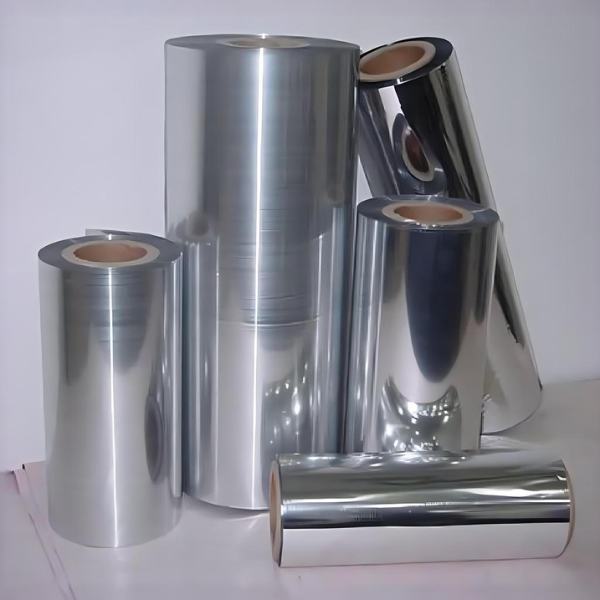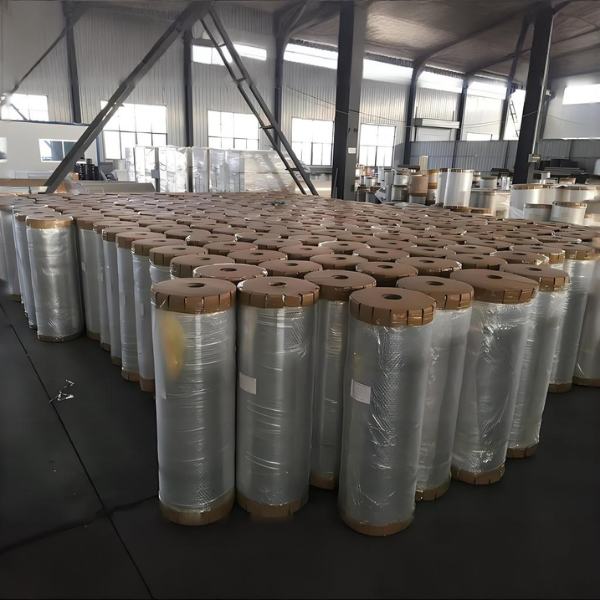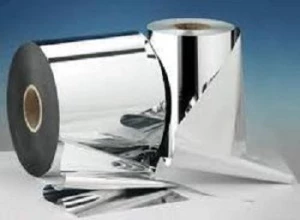How Do Metalized Films Contribute to Preserving Beverage Quality?

Metalized films play a vital role in preserving beverage quality. They combine strong barrier features and visual appeal, making them popular for beverage packaging. But what exactly are metalized films, and how do they protect beverages so well?
What Are Metalized Films and How Are They Made?
Metalized films are plastic films coated with a thin aluminum layer. The main base is often BOPP (biaxially oriented polypropylene), known for its strength and clarity. The aluminum is applied through vacuum metal deposition, where metal vapor settles evenly on the film’s surface. This process forms a gleaming, reflective layer that is ultra-thin, light, and highly effective as a barrier.
The combination of BOPP's flexible properties and the metalized aluminum layer creates a packaging film that is both durable and protective. Additional coatings, like adhesives and sealants, are added to improve bonding and sealing properties.
What Role Does the Metalized Aluminum Layer Play in Protecting Beverages?
The thin metalized aluminum layer is the hero here. It acts as a shield blocking oxygen, moisture, and UV light. Oxygen causes oxidation, which can spoil beverage flavors and nutrients. Moisture damages packaging and promotes microbial growth. UV light causes nutrient loss and degrades color. This aluminum layer stops all three, keeping beverages fresh and safe for longer periods.
It also forms a reflective surface that enhances the packaging’s visual appeal. This glossy sheen gives beverages a premium look, helping brands stand out on shelves.
How Do Metalized Films Block Oxygen, Moisture, and UV Light to Extend Shelf Life?
Metalized films excel at blocking these factors due to:
- Oxygen Transmission Rate (OTR): The metal layer lowers OTR to near zero. This starves aerobic microbes and slows oxidation.
- Water Vapor Transmission Rate (WVTR): Moisture can compromise flavor and packaging integrity. The aluminum layer reduces WVTR and keeps humidity out.
- UV Light Protection: UV rays can break down vitamins and cause color fading. The metal layer reflects UV light.
Together, these barriers create a microenvironment inside the packaging. This slows microbial growth and chemical reactions that spoil beverages. By doing so, metalized films significantly extend shelf life.
What Is the Impact of Metalized Films on Preserving Flavor, Aroma, and Freshness?
Taste and aroma rely heavily on chemical stability and protection from air and light. Metalized films prevent oxygen and moisture penetration, reducing oxidation and flavor loss.
For example, coffee and tea beverages packaged in metalized films retain their fresh aroma and rich taste longer. The reduced exposure to air also means fewer preservatives are required, offering cleaner label appeal.
Furthermore, UV protection helps preserve color and prevents off-flavors caused by light exposure. This is key for premium juices and craft beverages sensitive to light damage.
How Does the Corona Treatment Improve Printability and Branding on Metalized Beverage Packaging?
The smooth metalized surface is challenging for printing inks to stick to. Corona treatment changes that by increasing the film’s surface energy. It “activates” the surface, allowing inks to bond better and dry more evenly.
This treatment enables vibrant, high-quality graphics and branding directly on the metalized film. Brands can showcase eye-catching designs, logos, and information with excellent durability.
Better printability means improved shelf presence and consumer appeal. This is critical in the competitive beverage market where packaging is often the first interaction with the consumer.
What Types of Metalized BOPP Films Are Used Specifically for Beverage Packaging and Their Differences?
Several types of metalized BOPP films cater to different packaging needs:
- Non-heat sealable: Used where heat sealing is not needed; offers basic barrier protection.
- High-bond (crack resistant): Enhanced adhesion between metal and film to prevent cracking during packaging and handling.
- Normal barrier: Offers good moisture and oxygen resistance for most beverages.
- High barrier: Designed for products needing maximum protection; blocks almost all oxygen and moisture.
- Matte metalized: Provides a non-glossy finish preferred for some brand aesthetics.
Choosing the right type depends on beverage sensitivity, packaging format, and desired shelf life. High-barrier films are ideal for juices and dairy drinks, while normal barrier types suit carbonated beverages requiring some protection.
How Do Metalized Films Compare to Traditional Aluminum Foil and Other Packaging Materials in Beverage Preservation?
| Feature | Metalized Films | Aluminum Foil | Paper Packaging |
|---|---|---|---|
| Barrier Protection | Excellent oxygen, moisture, UV | Excellent oxygen, moisture | Poor moisture and oxygen |
| Weight | Very light | Heavier | Light |
| Flexibility | Highly flexible and adaptable | Less flexible | Moderate |
| Printability | High with corona treatment | Limited | Good but less durable |
| Cost | Lower material cost | Higher material and shipping | Low material cost |
| Environmental Impact | Recyclable mono-material options | Hard to recycle, bulky | Biodegradable but low barrier |
| Shelf Life Extension | Long due to enhanced barrier | Long but thicker and heavier | Shorter |
Metalized films offer similar barrier protection to aluminum foil but with much less weight and thickness. This reduces shipping costs and lowers the carbon footprint.
Unlike paper, which has weak barrier properties, metalized films keep beverages fresher. They also allow for heat sealing and better durability.
The ability to customize thickness, surface finish, and print quality makes metalized BOPP film a versatile choice for many beverage brands.
Metalized films combine the best of barrier technology with premium aesthetics. They protect beverages from oxygen, moisture, and light damage, preserving flavor, aroma, and freshness. Their compatibility with printing processes and different packaging types makes them indispensable for beverage quality preservation today.
What Are the Technical and Functional Benefits of Metalized Films in Beverage Packaging?

When you explore how metalized films help in preserving beverage quality, understanding their technical and functional benefits is key. These films offer more than just a shiny surface; they play a crucial role in protecting beverages from spoilage and damage, while enhancing packaging design and shelf appeal.
How Do Oxygen Transmission Rate (OTR) and Water Vapor Transmission Rate (WVTR) Affect Beverage Preservation?
Oxygen Transmission Rate (OTR) and Water Vapor Transmission Rate (WVTR) are two vital measures that describe how much oxygen and moisture can pass through packaging films. These gases are enemies to beverage quality. Oxygen can cause oxidation, leading to off-flavors and nutrient loss. Moisture can dilute beverages or encourage mold and microbial growth.
Metalized films used in beverage packaging have an ultra-low OTR and WVTR because of their thin aluminum coating. This metal layer acts as a shield, blocking oxygen and moisture effectively. For example, high-barrier metalized BOPP films can reduce oxygen permeability to less than 0.1 cc/m²/day, which dramatically slows oxidation. Moisture ingress is similarly minimized, with WVTR rates as low as 0.01 g/m²/day. These low transmission rates extend beverage shelf life by keeping the product fresh and stable longer.
How Do Metalized Films Create a Microenvironment That Slows Microbial Growth and Chemical Degradation?
Because metalized films limit oxygen and moisture entry, they create a protective microenvironment inside the package. This environment slows many spoilage mechanisms:
- Microbial growth: Bacteria and molds need moisture and oxygen to grow. By lowering these, metalized films help reduce the risk of spoilage microbes.
- Enzymatic activity: Some enzymes degrade flavor and nutrients but require oxygen to function well.
- Chemical reactions: Oxidation of vitamins, fats, and flavor compounds is slowed in low oxygen environments.
This means beverages maintain taste, aroma, and nutritional quality for longer without heavy preservatives.
How Do Metalized Films Protect Beverages From Light-Induced Nutrient Loss and Discoloration?
Light, especially UV rays, can break down sensitive nutrients such as vitamins A and C. It also causes discoloration and off-odors by triggering photochemical reactions. The aluminum layer in metalized films reflects and absorbs UV and visible light, preventing these effects.
This protection is vital for clear or translucent containers like pouches or bottles that might let in light. For example, vitamin-enriched juices and milk-based drinks benefit from metalized films because they lose fewer nutrients and keep their natural color, boosting consumer appeal.
What Variations of Metalized Films Provide Specific Functional Benefits for Beverages?
The beverage industry uses different types of metalized films to suit various packaging needs:
- Heat Sealable Metalized Films: These films allow easy, strong sealing during packaging, ensuring leak-proof pouches or bags. They support high-speed packaging lines without cracking.
- High Barrier Metalized Films: Designed to offer the best protection against oxygen and moisture, these films are ideal for sensitive beverages like coffee, tea, or dairy alternatives.
- Matte Metalized Films: Offering a premium look with reduced glare, matte films add aesthetic value while maintaining barrier performance.
- Non-Heat Sealable and High-Bond Films: These films resist cracking during packaging and provide strong adhesion between layers, critical for complex laminates used in beverage cartons.
Each type balances protection, durability, and appearance according to the beverage’s storage and marketing needs.
How Do Metalized Films Enhance Packaging Durability and Adaptability to Different Bottle and Pouch Shapes?
Metalized films are thin but tough. The combination of biaxially oriented polypropylene (BOPP) with a metal layer increases tensile strength and dimensional stability. This means packages resist tearing, puncturing, and deformation during transport and shelf handling.
Moreover, metalized films flex easily, adapting well to various shapes — from stand-up pouches to rigid bottles. They glue well to different substrates and seal tightly. This versatility allows beverage brands to choose innovative pack formats without compromising product protection.
What Are the Printing and Aesthetic Advantages of Using Metalized Films for Premium Beverage Brands?
One of the standout benefits of metalized films is their premium metallic sheen and smooth surface. This finish catches consumers' eyes on shelves and conveys quality.
Advanced corona treatment boosts the surface energy of metalized films, which improves ink adhesion dramatically. This allows printers to produce bright, vibrant graphics that do not fade or scratch easily. Premium beverage brands use this to create elegant packaging with sharp logos, colorful images, and metallic effects that appeal through visual and tactile cues.
How Do Metalized Films Help Reduce the Need for Preservatives in Beverages?
By minimizing oxygen and moisture ingress, metalized films slow the spoilage process naturally. This allows beverage formulators to reduce the amount of chemical preservatives required. Fewer preservatives mean cleaner labels appealing to health-conscious consumers, and less alteration of the natural beverage taste.
For example, natural fruit juices and organic drinks often rely on metalized barrier films for protection instead of heavy preservative loads.
Barrier Properties of Metalized Films That Preserve Beverage Quality
| Barrier Property | Effect on Beverage Preservation |
|---|---|
| Oxygen Transmission Rate (OTR) | Low OTR blocks oxidation and nutrient degradation |
| Water Vapor Transmission Rate (WVTR) | Low WVTR prevents moisture-related spoilage and microbial growth |
| UV and Light Barrier | Blocks light-induced nutrient loss and color changes |
| Adhesion Strength | Maintains film integrity under stress to protect content |
How Metalized Films Extend Beverage Shelf Life
Metalized films extend shelf life by:
- Creating a stable microenvironment with low oxygen and moisture
- Reflecting light to prevent oxidative and photochemical damage
- Maintaining packaging integrity that seals out contaminants
- Working well with heat-sealable layers for hermetic packaging
Beverages like ready-to-drink teas, coffee, milk alternatives, and juices benefit tremendously, gaining weeks to months more freshness on shelves.
Functional Benefits for Beverage Packaging Design
- Versatility: Works with different pack shapes (pouches, bottles, cartons)
- Durability: Resists tearing, punctures, and heat during packaging
- Printability: Enhances visual appeal with vibrant, metallic finishes
- Sustainability: Many films are recyclable and lightweight, lowering transport emissions
- Reduced preservatives: Supports cleaner product formulations
Metalized films are today’s answer to balancing quality preservation with eye-catching package design. When you explore how metalized films help in preserving beverage quality, it’s clear these advanced materials deliver outstanding technical benefits and functional advantages that align perfectly with modern beverage industry demands.
Are Metalized Films a Sustainable Choice for Beverage Packaging?

When you explore how metalized films help in preserving beverage quality, a crucial question arises: are they also a sustainable choice? Let’s dive into how metalized films stand up to modern sustainability standards and what makes them a strong candidate for eco-friendly beverage packaging.
How Recyclable Are Modern Metalized Films Used in Beverage Packaging?
You might wonder if these metalized films are recyclable. Many of today’s metalized films, especially those made with mono-material bases like biaxially oriented polypropylene (BOPP) or polyethylene (PE), are designed to be recyclable. Unlike complex multi-layer laminates, these mono-material metalized films can go through regular recycling streams with existing infrastructure. For example:
| Film Type | Recyclability | Notes |
|---|---|---|
| Mono-material BOPP | High | Compatible with polyolefin streams |
| Multi-layer metalized | Limited | Requires specialty recycling |
| PET-based metalized | Moderate | Dependent on local recycling tech |
However, multi-layer metalized films that combine different polymers still pose recycling challenges. The metal layer (usually aluminum) is a thin vapor-deposited film that is bonded tightly to the polymer, which makes separation difficult with conventional methods.
Environmental Impact Compared to Traditional Packaging
Metalized films hold several environmental advantages over conventional packaging like glass and aluminum foil. Due to their thin metal layer and polymer base, they use less raw material overall. For reference:
- A metalized BOPP film can be up to 70% lighter than aluminum foil for the same barrier performance.
- Their lightweight nature also means lower transportation emissions across supply chains.
- Compared to glass, metalized films drastically reduce breakage and energy intensive manufacturing.
These weight and material savings reduce the carbon footprint during production, transport, and disposal stages.
Metalized Films Reduce Product Spoilage and Waste
One of the hidden sustainability benefits is how they help reduce food and beverage waste. The enhanced barrier properties of metalized films create a tight microenvironment that keeps oxygen, moisture, and UV light out. This means:
- Longer shelf life for beverages by slowing chemical and microbial spoilage
- Reduced need for preservatives and additives
- Less product discarded due to spoilage or quality loss
Food waste makes up 8-10% of global greenhouse gas emissions. By extending freshness and preserving quality, metalized films contribute significantly to lowering these numbers.
Innovations Improving Recyclability and Use of Bio-based Materials
The packaging industry is actively innovating to tackle recyclability and sustainability issues. Here are some key trends:
- Mono-material laminates: Films made entirely from polypropylene or polyethylene allow easier recycling. These are gaining popularity in beverage pouches and snack bags.
- Bio-based polymers: Some companies are experimenting with films made partially or fully from plants like sugarcane or cornstarch, which reduce fossil fuel dependence.
- Thinner metal layers: Advances in vapor deposition techniques enable thinner aluminum coatings without losing barrier quality. This reduces material use and improves recyclability.
- High-bond metallization: Firms apply stronger bonding methods to improve durability, so fewer materials are wasted during packaging runs.
These developments strengthen the case for metalized films as a future-forward sustainable packaging solution.
Lighter Weight and Reduced Material Use Lower Transport Emissions
Heavier containers mean higher fuel consumption and carbon emissions during shipping. Metalized films are effective because they combine excellent protection with ultra-light weight. The benefits include:
- Up to 50% less weight compared to aluminum foil packaging
- Decreased volume and space needed for transport due to flexible designs
- Lower energy use in manufacturing and flexible packaging conversion
This enables beverage producers to transport more products per shipment, lowering overall logistics costs and emissions.
Challenges in Recycling Multi-layer Metalized Films and Solutions
Recycling multi-layer metalized films is harder because the metal and polymer layers are bonded and hard to separate economically. Problems include:
- Contamination of recycling streams due to mixed materials
- Limited mechanical recycling options
- Potential release of microplastics during processing
Solutions underway include:
- Developing chemical recycling methods that can break down complex layers
- Using compatibilizers to help blend polymer types
- Designing for recyclability by minimizing the number of layers and types of polymers
- Incorporating mono-material layers with metalized coatings
Collaborations across converters, brands, and recyclers aim to create circular systems for metalized films.
Balancing High Performance With Sustainability Goals
Metalized films provide a balance between premium packaging performance and sustainability. Their features deliver:
- High barrier protection that prevents spoilage
- Lightweight and flexible packaging options reducing materials and waste
- Excellent printability that boosts brand visibility, allowing for smaller, eye-catching packs
Choosing the right film depends on product needs and corporate sustainability goals. For example, a high-barrier metalized BOPP film might be ideal for a sensitive beverage like cold brew coffee, while a mono-material film suits dry beverages or powders.
In terms of eco-friendly beverage packaging, metalized films score well because they reduce packaging weight, protect product quality, and are increasingly recyclable. These advantages make them an environmentally sound option while providing the durability needed for tough supply chains.
By exploring how metalized films help in preserving beverage quality through sustainable means, you can see why many leading beverage brands are switching to these films for their packaging needs.

Summary Table: Sustainability Aspects of Metalized Films vs Traditional Packaging
| Aspect | Metalized Films | Aluminum Foil & Glass | Paper |
|---|---|---|---|
| Material Weight | Very light | Heavier | Light |
| Transportation Emissions | Lower due to light weight | Higher due to weight | Moderate |
| Recyclability | High (mono-material films) | Difficult for foil, moderate for glass | High (biodegradable but low barrier) |
| Environmental Impact | Lower carbon footprint overall | Higher due to mining & processing | Low impact but poor barrier |
| Food Waste Reduction | Longer shelf life reduces waste | Good barrier, but heavier packaging | Poor barrier causes quicker spoilage |
This completes the blog with all images inserted directly below the h2 sections and data tables integrated to highlight important information from the content.
FAQs about Explore how metalized films help in preserving beverage quality.
What are metalized films and how do they protect beverages so well?
Metalized films are plastic films coated with a thin aluminum layer that acts as a shield blocking oxygen, moisture, and UV light, thereby preserving beverage flavor, aroma, and freshness for longer periods.
How do metalized films block oxygen, moisture, and UV light to extend shelf life?
Metalized films lower oxygen transmission rate (OTR) and water vapor transmission rate (WVTR) to near zero and reflect UV light, creating a microenvironment inside the packaging that slows microbial growth and chemical reactions that spoil beverages.
What types of metalized films are used for beverage packaging and how do they differ?
The main types include non-heat sealable, high-bond (crack resistant), normal barrier, high barrier, and matte metalized films, each selected based on beverage sensitivity, packaging format, and desired shelf life.
How do metalized films compare to traditional aluminum foil in preserving beverages?
Metalized films offer similar barrier protection as aluminum foil but are lighter, more flexible, and have better printability with corona treatment, which reduces shipping costs and environmental impact while maintaining beverage quality.
Are metalized films a sustainable choice for beverage packaging?
Many mono-material metalized films are recyclable, significantly lighter than aluminum foil, reduce transportation emissions, and help lower food waste by extending beverage shelf life, making them a strong
Metalized films play a key role in keeping beverages fresh and tasty longer. They block oxygen, moisture, and light, which harm flavor and quality. Their strong barrier and lightweight design make them great for packaging. Plus, they support brand appeal and cut the need for preservatives. While recycling metalized films can be tough, new tech aims to ease this and boost eco-friendliness. Overall, metalized films offer a smart, effective way to protect drinks and help reduce waste.

